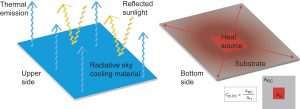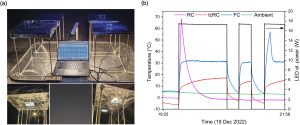Doc. dr. Professor Primož Poredoš, in collaboration with colleagues from the Laboratory for Environmental Technologies in Buildings at the Faculty of Mechanical Engineering, UL, and researchers from the ITEWA innovation team at Shanghai University, has developed a concentrator based on the AsymSkyCool method that enables cooling of buildings and appliances without the use of electricity. The concentrator takes advantage of the ‘cold of space’ – the extremely low temperatures of deep space, which can be as low as minus 15°C compared to the surrounding environment – and uses a special method to concentrate it and direct it towards a heat source. Using space as a cooling source enables environmentally friendly, efficient and sustainable cooling of devices that consume large amounts of electricity, such as LED lights, batteries and electric motors.
With increasing demands for efficient and sustainable energy use, researchers and industry are working hard to find innovative solutions to cool appliances, buildings and infrastructure without using electricity, and in particular to find ways to reduce the carbon footprint of industry and households. For example, the average electricity consumption for cooling the electric motor of a refrigerator is typically between 200 and 400 kilowatt hours (kWh) per year. If we compare this to the amount of carbon dioxide produced, one of the most problematic greenhouse gases, this equates to just over 150 kg of CO2 emissions per year, which is roughly equivalent to driving a car over 1,000 to 1,500 km. In this context, the development of efficient cooling methods is key to meeting the challenges of environmental heat loads and CO2 emissions.
The concentrator based on the AsymSkyCool method represents a breakthrough in the study of passive cooling methods, as it allows the cooling energy generated to be better concentrated and directed towards a specific heat source (LED light, electric motor, batteries, etc.). In this method (Figure 1), the heat source is coupled to the RC material via a substrate (i.e. a large surface area of very high thermal conductivity). The latter plays an important role in passively cooling buildings and surfaces to temperatures below ambient air, as it is designed to efficiently radiate heat into the cold space while minimising the absorption of solar radiation and heat from the atmosphere. The whole complex of the AsymSkyCool method (heat source, substrate and RC material) allows heat to be transferred from a smaller heat source to a larger and cooler area – hence the term “Asym”, i.e. asymmetric – provided by the RC material, resulting in a deconcentration of heat or a concentration of cold. The research results were published in Energy & Environmental Science (IF: 32.5), one of the top three journals in the field of environmental science and energy, and the top scientific journal in the field of chemical engineering.

Figure 1: Concept of an all-day cooling energy concentrator with radiative sky cooling, serving as an emitter of energy-rich electromagnetic waves into space.
The experiment was conducted in different geographical locations (Ljubljana, Shanghai and Kunming), demonstrating the performance of the AsymSkyCool method over a wide range of temperature and humidity conditions, making this study significantly different from previous studies that have typically relied on a limited dataset from a single location and evaluated its performance under minimal changes in ambient air conditions.
The lead researcher, doc. dr. Primož Poredoš emphasised the practical demonstration of the applicability of the AsymSkyCool method: “The experimental study was carried out by cooling high-energy LED luminaires for several days in an outdoor environment (Figure 2). The results exceeded our expectations, as the cooling energy concentration approach proved to be much better than the active cooling approach based on an extended surface and a fan. The flexibility of the AsymSkyCool method has also been tested in less favourable environmental conditions, as radiative cooling performance is strongly influenced by solar radiation, the amount of water vapour in the atmosphere and cloud cover. In doing so, the authors of the study have demonstrated the robustness of this method in practice under a wide range of operating conditions encountered in a real-world environment“.

Figure 2: a) Experimental setup used for the proof-of-concept with high-energy LED diodes using the concentration of radiative sky cooling. b) Temperature change over time in the case of a sample without radiative sky cooling concentration (RC), a sample based on radiative sky cooling concentration with thermal insulation (tcRC), and an active device based on forced convection (FC).
Although the research has demonstrated a very promising concept for high-efficiency passive cooling of large power-consuming appliances, the researchers aim to develop a concentrator in the future that will move the performance scale up to 200 kW m2. This will enable entirely new approaches to carbon-free cooling of energy-intensive systems such as large greenhouse complexes, thermal power plants and even nuclear reactors.
Artilce is avaliable at: https://doi.org/10.1039/D3EE03214K
